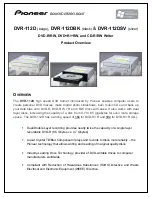
Electrical Installation
AGD155 Product Manual Rev.2.2
Page 19
Name
Ground Domain
Notes
Analog inputs/outputs (not isolated) GND
Brake control output
General
External DC power supply
Regeneration output
PGND
External shunt resistor
Ethernet communication
General
Isolated
Other communication
GND
Not isolated (unless otherwise
stated in manual)
Grounding Policy
Grounding of the product must comply with the following guidelines:
The enclosures and other external parts that may be touched by the user are in the
safe domain
.
The AGD155 must be connected to protective earth (PE) and connected to the building’s ground.
PE is protected with an earth-leakage circuit breaker (ELCB); hence it is safe to touch. Refer to
PGND is connected directly to mains wires, hence it is just as dangerous as mains to the user.
All shielded cables, including but not limited to motor, encoders, and power input, have their
shield connected to PE as part of the external metal enclosure.
PGND is bypassed to PE with low capacitance (around 10 nF) for EMI/EMC purposes.
It is critical to avoid ground loops in the system. A ground loop allows currents to return by two
or more different paths, causing electromagnetic interference or even damage to wires.
The system designer must carefully examine all GND connections in the system to ensure that no
loops are created, and that all GND-referenced signals have a GND wire nearby (for both return
currents and common mode voltage).
3.3.6 PT100/PT1000 Temperature Sensors
AGD155 supports two types of temperature sensors:
The PT100 temperature sensor is a platinum resistance thermometer. Its resistance value at 0°C
is
100
Ω
.
The PT1000 temperature sensor also a platinum resistance thermometer. Its resistance value at
0°C is
1000
Ω
.
The temperature sensor is wired to the X4 connector as shown in the following table.
PT100/PT1000 Temperature Sensor Wiring
Pin #
Pin Name
PT100
PT1000
3
PT1000_EN
NC
Short to pin 6
6
GND
NC
Short to pin 3
8
RTD+
PT100+
9
RTD-
PT100-
PT1000-
















































